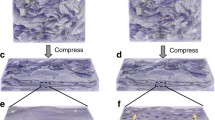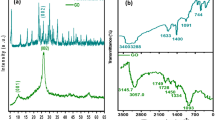Abstract
One of the promising supercapacitors for next-generation energy storage is zinc-ion hybrid supercapacitors. For the anode materials of the hybrid supercapacitors, three-dimensional (3D) graphene frameworks are promising electrode materials for electrochemical capacitors due to their intrinsic interconnectivity, excellent electrical conductivity, and high specific surface area. However, the traditional route by which 3D graphene frameworks are synthesized is energy- and time-intensive and difficult to apply on a large scale due to environmental risks. Here, we describe a simple, economical, and scalable method of fabricating grafoil (GF) directly into a graphite–graphene architecture. Both synthesizing of a porous structure and functionalization with interconnected graphene sheets can be simultaneously achieved using electrochemically modified graphite. The resultant graphite electrode provides a high capacitance of 140 mF/cm2 at 1 mA/cm2, 3.5 times higher than that of pristine grafoil, keeping 60.1% of its capacitance when the current density increases from 1 to 10 mA/cm2. Thus, the method to produce 3D graphene-based electrodes introduced in the current study is promising for the applications of energy storage devices.





Similar content being viewed by others
References
Oskueyan G, Lakouraj MM, Mahyari M (2021) Fabrication of polyaniline–carrot derived carbon dots/polypyrrole–graphene nanocomposite for wide potential window supercapacitor. Carbon Lett 31:269–276
Karuppasamy M, Muthu D, Haldorai Y, Kumar RTR (2020) Solvothermal synthesis of Fe3S4@graphene composite electrode materials for energy storage. Carbon Lett 30:667–673
Li P, Ma X, Liang Y, Tan J, Wang L (2019) Preparation and electrochemical capacitive properties of C-MnO2 composite with foam-like structure based on modified rubber. Carbon Lett 29:547–552
Ma Y, Chang H, Zhang M, Chen Y (2015) Graphene-based materials for lithium-ion hybrid supercapacitors. Adv Mater 27:5296–5308
Shen L, Yu L, Yu X-Y, Zhang X, Lou XW (2014) Self-templated formation of uniform NiCo2O4 hollow spheres with complex interior structures for lithium-ion batteries and supercapacitors. Angew Chem 54:1868–1872
Ding J, Wang H, Li Z, Cui K, Karpuzov D, Tan X, Kohandehghan A, Mitlin D (2015) Peanut shell hybrid sodium ion capacitor with extreme energy-power rivals lithium ion capacitors. Energy Environ Sci 8:941–955
Wang X, Kajiyama S, Iinuma H, Hosono E, Oro S, Moriguchi I, Okubo M, Yamada A (2015) Pseudocapacitance of MXene nanosheets for high-power sodium-ion hybrid capacitors. Nat Commun 6:6544
Komaba S, Hasegawa T, Dahbi M, Kubota K (2015) Potassium intercalation into graphite to realize high-voltage/high-power potassium-ion batteries and potassium-ion capacitors. Electrochem Commun 60:172–175
Yang B, Chen J, Liu L, Ma P, Liu B, Lang J, Tang Y, Yan X (2019) 3D nitrogen-doped framework carbon for high-performance potassium ion hybrid capacitor. Energy Storage Mater 23:522–529
Dong L, Ma X, Li Y, Zhao L, Liu W, Cheng J, Xu C, Li B, Yang Q-H, Kang F (2018) Extremely safe, high-rate and ultralong-life zinc-ion hybrid supercapacitors. Energy Storage Mater 13:96–102
Zhang J, Liu X, Wang J, Shi J, Shi Z (2016) Different types of pre-lithiated hard carbon as negative electrode material for lithium-ion capacitors. Electrochim Acta 187:134–142
Fang G, Zhou J, Pan A, Liang S (2018) Recent advances in aqueous zinc-ion batteries. ACS Energy Lett 3:2480–2501
Tang B, Shan L, Liang S, Zhou J (2019) Issues and opportunities facing aqueous zinc-ion batteries. Energy Environ Sci 12:3288–3304
An G-H, Hong J, Pak S, Cho Y, Lee S, Hou B, Cha SN (2020) 2D metal Zn nanostructure electrodes for high-performance Zn ion supercapacitors. Adv Energy Mater 10:1902981
Li Y, Fu J, Zhong C, Wu T, Chen Z, Hu W, Amine K, Lu J (2019) Recent advances in flexible zinc-based rechargeable batteries. Adv Energy Mater 9:1802605–1802614
Yang J, Yu C, Fan X, Qiu J (2014) 3D architecture materials made of NiCoAl-LDH nanoplates coupled with NiCo-carbonate hydroxide nanowires grown on flexible graphite paper for asymmetric supercapacitors. Adv Energy Mater 4:1400761
Yu M, Huang Y, Li C, Zeng Y, Wang W, Li Y, Fang P, Lu X, Tong Y (2015) Building three-dimensional graphene frameworks for energy storage and catalysis. Adv Funct Mater 25:324–330
Song Y, Liu T-Y, Xu X-X, Feng D-Y, Li Y, Liu X-X (2015) Pushing the cycling stability limit of polypyrrole for supercapacitors. Adv Funct Mater 25:4626–4632
Song Y, Feng D-Y, Liu T-Y, Li Y, Liu X-X (2015) Controlled partial-exfoliation of grafoil and integration with MnO2 nanosheets for electrochemical capacitors. Nanoscale 7:3581–3587
Shornikova ON, Kogan EV, Sorokina NE, Avdeev VV (2009) The specific surface area and porous structure of graphite materials. Russ J Phys Chem A 83:1022–1025
Liu F, Cao X, Cui L, Yue L, Jia D, Liu J (2019) Scalable fabrication of electrochemically oxidized and moderately reduced graphite paper electrode for flexible energy storage with ultrahigh rate capability. J Power Sources 421:169–178
Mathew EE, Balachandran M (2021) Crumpled porous graphene for supercapacitor applications: a short review. Carbon Lett 31:537–555
Wang R, Xu C, Lee J-M (2016) High performance asymmetric supercapacitors: new NiOOH nanosheet/graphene hydrogels and pure graphene hydrogels. Nano Energy 19:210–221
Yang H, Yang J, Bo Z, Zhang S, Yan J, Cen K (2016) Edge effects in vertically oriented graphene based electric double-layer capacitors. J Power Sources 324:309–316
Qiu B, Xing M, Zhang J (2018) Recent advances in three-dimensional graphene based materials for catalysis applications. Chem Soc Rev 47:2165–2216
Youn SC, Kim DW, Yang SB, Cho HM, Lee JH, Jung H-T (2011) Vertical alignment of reduced graphene oxide/Fe-oxide hybrids using the magneto-evaporation method. Chem Commun 47:5211–5213
Xu Y, Sheng K, Li C, Shi G (2010) Self-assembled graphene hydrogel via a one-step hydrothermal process. ACS Nano 4:4324–4330
Lv W, Zhang C, Li Z, Yang Q-H (2015) Self-assembled 3D graphene monolith from solution. J Phys Chem Lett 6:658–668
Qian O, Lin D, Zhao X, Han F (2019) Vertically oriented grid-like reduced graphene oxide for ultrahigh power supercapacitor. Chem Lett 48:824–827
Gomez-Navarro C, Weitz RT, Bittner AM, Scolari M, Mews A, Burghard M, Kern K (2007) Electronic transport properties of individual chemically reduced graphene oxide sheets. Nano Lett 7:3499–3503
Hummers WS, Offeman RE (1958) Preparation of graphitic oxide. J Am Chem Soc 80:1339
Kwon YJ, Kwon Y, Park HS, Lee JU (2019) Mass-produced electrochemically exfoliated graphene for ultrahigh thermally conductive paper using a multimetal electrode system. Adv Mater Interfaces 6:1900095
Ni Z, Wang Y, Yu T, Shen Z (2008) Raman spectroscopy and imaging of graphene. Nano Res 1:273–291
Wang C, Zhou Y, Sun L, Zhao Q, Zhang X, Wan P, Qiu J (2013) N/P-codoped thermally reduced graphene for high-performance supercapacitor applications. J Phys Chem C 117:14912–14919
Funding
This work was supported by the Korea Evaluation Institute of Industrial Technology (KEIT) through the Technology Innovation Program under the “Development of an Automated System for the Electrochemical Exfoliation of Synthetic Graphite Production Residue and Multifunctional Composites” project (No. 20006820) funded by the Ministry of Trade, Industry & Energy of Korea and the Korea Research Institute of Chemical Technology (KRICT) through the K-materials R&D program under the “Development of petcoke derived synthetic graphite” project (No. BSF22-610) funded by the Ministry of Science and ICT.
Author information
Authors and Affiliations
Corresponding authors
Ethics declarations
Conflict of interest
The authors have no competing interests to declare that are relevant to the content of this article.
Additional information
Publisher's Note
Springer Nature remains neutral with regard to jurisdictional claims in published maps and institutional affiliations.
Rights and permissions
About this article
Cite this article
Kwon, Y.J., Park, H.S. & Jeon, YP. Graphite–graphene architecture for Zn-ion hybrid supercapacitor electrodes. Carbon Lett. 32, 1307–1313 (2022). https://doi.org/10.1007/s42823-022-00362-6
Received:
Revised:
Accepted:
Published:
Issue Date:
DOI: https://doi.org/10.1007/s42823-022-00362-6




